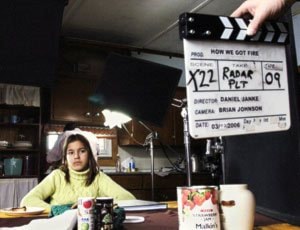CARCROSS
It was hard to miss the film set.
Floodlights, bystanders, crew and equipment spilled onto Bennett Street in downtown Carcross Tuesday.
The jarring crackle of walkie-talkies, the smell of hot catering, and hushed whispers — “We’re rolling,” added to the general bustle.
Inside the tiny log-cabin set, the film crew was moving lights, changing camera batteries and repositioning furniture, preparing for the last shot before lunch.
“I need fresh bannock,” said young Haines Junction actor Jonnie-Lyn Kushniruk.
“This piece is all hard.”
Production designer Emma Barr hurried to bring her a new, jam-covered piece.
Once the shot was set up, director Daniel Janke stood beside the camera operator and coached Kushniruk — “Bigger eyes … look more scared — OK, take a bite of bannock.”
Then he called “cut,” and the cabin emptied for lunch.
Munching on stewed meat and rice, Janke was found chatting with a local First Nations elder in the production headquarters at the Carcross/Tagish First Nations Community Centre.
“We have four generations of family in this film,” said Janke.
Based on a story told by the late Kitty Smith, the film How People Got Fire features Smith’s daughter May Hume, playing the role of her mother.
One of Smith’s granddaughters and one of her great grandchildren also appear in the film.
In the mid-‘80s Janke heard Smith tell the story of how people got fire at a potlatch.
Inspired, he turned the story into a radio piece with renowned storyteller Louise Profeit-LeBlanc.
“I played it for Kitty shortly before she passed away,” said Janke.
“And Kitty said, ‘That’s pretty good.’”
After her death, Janke felt obliged to wait until the family approached him before doing more with Smith’s story.
Then, about four years ago, he and Smith’s granddaughter Judy Gingell started discussing the possibility of a film featuring the story.
Around that time, Janke met with National Film Board producer Svend-Erik Erikson, who was in the territory to talk with local filmmakers and present animation workshops.
After several discussions with Erikson, Janke decided to make an animated film to illustrate Smith’s story.
“This gives us the freedom to make a very, beautiful, poetic, surreal world,” he said.
“It’s an amazing visual story, and to do it this way allows me to tell another story within the story.”
Kitty Smith’s tale is embedded in the story of a little girl, Tish, who regularly stops at her grandmother’s house after school and slowly learns to be a storyteller.
“This little girl is dealing with the jungle of kids’ life and becomes empowered when she learns she’s a storyteller herself,” said Janke.
The whole story takes place in the mind of Tish, as a dream, he added.
“And the animation gives it an edge, because with animation you can do anything.”
“Some of the little spot animations that Daniel would like to see in the film are little symbolic things,” said Erikson.
“Like a little radar pops out of Tish’s head and moves around when she’s feeling certain ways. And you’d never do that in live action, but we can do it in animation.”
Another little boy in the film has all these animated flies flying around his head, suggesting his scattered, crazy personality, while another girl’s glasses reflect her own image standing in front of a mirror.
The images cloud her vision suggesting she’s a teenager hung up on who she is and how she appears.
“There are lots of elements and layers like that,” said Janke.
There’s also a book that comes alive and demands attention by popping open and flipping pages.
“Animation takes you into a different kind of reality than live action,” said Erikson.
“You’re sort of anchored to reality when you see live action but when it’s animation you free certain bonds and the fantasies can run a little bit wilder.
“Animation is only limited by the imagination, while live action is limited by the world.”
Smith’s internal story will be done in two-dimensional animation, while the overarching story will weave in and out of animation using rotoscoping techniques and some 3-D animation.
Rotoscoping involves drawing over and adding colour to original digital images, to give real film footage a surreal, cartoon feel.
“But our characters are real — I want to get away from the saccharine sweet of Disney,” said Janke.
“It is important that we understand the story and treat it with respect.”
By shooting in Carcross with a First Nations cast, Janke hoped to “share the wealth,” and accurately represent the First Nations family he’s portraying.
“The community is excited about it,” said one of Smith’s granddaughters over lunch.
“It is nice to see the respect that is being put forward with respect to my grandmother.
“And he’s used First Nations children from (Carcross in the film) and the caterers are from here.”
“The food has been so good — a few days ago we had bannock and moose stew for lunch,” said head costumer Linda Talbot.
These caterers were not new to film sets.
“We did some catering for a movie on the Skagway Road,” said cook Louise Johns.
“But this group of people is really nice to work with — they ate what I gave them.”
The film crew was largely made up of Yukoners, who came together for the project with just a few weeks notice.
“I only got the funding a month ago,” said Janke.
“And I wanted to shoot in full-on winter, so I pushed the schedule.”
The film only required five days of shooting, but the animation will take months to develop and will eat up most of the film’s half-a-million-dollar budget.
Janke plans to set up a rotoscoping studio in Whitehorse and hire two local animators, to assist professional animator Jay White.
Two animators in Vancouver have already been working on the film for over a year, he said.
How People Got Fire should be released by Christmas.
